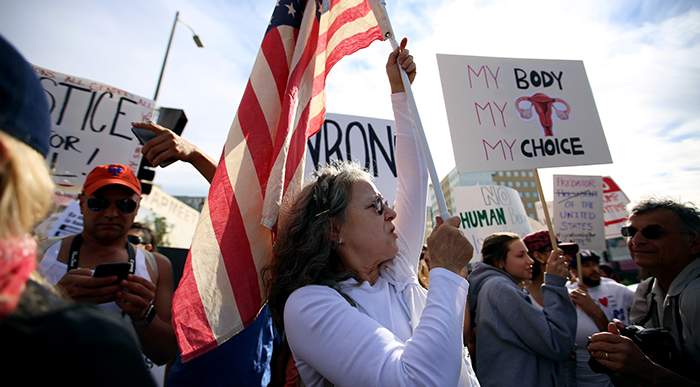In the weeks following Donald Trump’s election, there have been various and sundry acts of resistance that have sprouted up all over social media. Resistance is good, but the time has come to think about what tactics are effective, and which have about as much impact as an angry tweet. Some protests, like petitions against the Electoral College or cabinet appointments, are doomed. Others, like the Dakota Access Pipeline protest, have made definitive progress.
One of the most trusted methods of protest is the boycott. Both the Right and the Left have launched boycotts since the election, but not all boycotts are created equal. There are a number of factors that can make a boycott effective or impotent, and understanding them will help you weigh the potential success of your action before you waste valuable resources on something that won’t work.
Goals
It's not enough for @MoveOn to say "hands off medicare." Please say "MEDICARE FOR ALL." That has to be the message.
— #FreeBresha (@prisonculture) December 8, 2016
On a recent episode of the activist podcast Delete Your Account (@deleteuracct), hosts Kumars Salehi (@KumarsSalehi) and Roqayah Chamseddine (@roqchams) were joined by Mariame Kaba (@prisonculture) to discuss organizing in the Trump era. One of Kaba’s recurring themes was that actions are not ends in themselves. A protest may make you feel good, but if there is no goal, you can’t hope to achieve anything. She offered some examples from our current situation. Protesting cabinet appointments is a non-starter, since a successful protest would mean shifting Republican votes away from confirmation: highly unlikely. By contrast, a movement to protect Medicare, a popular program among older, whiter, more rural voters, could lead to a potential winning coalition.
If you look at recent boycotts against Trump properties and Ivanka Trump clothing on the Left, and Starbucks and Kellogg’s on the Right, you don’t see any concrete goals. Awareness is nice, but it doesn’t raise your wages, save your environment, or protect your human rights. Awareness is the first step towards achieving goals, but is not a goal in itself.
Buy-in
Buying decisions are almost always irrelevant, unless part of an organized, politicized boycott. (Boycott being just one tactic employed.) https://t.co/7P6hui8o0c
— Bhaskar Sunkara (@sunraysunray) November 25, 2016
Once you know your goals, you have to convince others that these goals are desirable and achievable. Many well-meaning people conflate buying choices with boycotting. A successful boycott is an organized boycott. Simply declaring that you won’t stay at a Trump hotel is nice, but to have an impact, you have to get a lot of people to say they won’t stay at Trump hotels. Ideally, those people will be able to say “we won’t stay at Trump hotels until [x,y, or z] happens.” Then, the coalition and their goals will be so compelling that people are attracted to the cause.
If you look at some of the most successful boycotts in history, such as Cesar Chavez’s grape boycott and Martin Luther King’s Montgomery Bus Boycott, you immediately see similarities. These protests had a built-in buy-in from groups like labor unions, religious organizations, and ethnic communities. If you don’t have buy-in for your boycott, it will fail.
Targeted Boycotts
61 years ago today, the Montgomery Bus Boycott began. It was the birth of the modern-day Civil Rights Movement. #goodtrouble pic.twitter.com/Fm4Xc1ekZy
— John Lewis (@repjohnlewis) December 5, 2016
Once you’ve got goals and you have people rallying behind those goals, you have to hit your target where it hurts. Boycotts are generally David vs. Goliath affairs. The odds that even several thousands people are going to put a dent in Starbucks, Kellogg’s, or the U.S. government bottom-line are long.
Successful boycotts tend to have concentrated targets. Chavez targeted California table grapes. The Bus Boycott was only concentrated in one city. Once that first boycott was successful, this generated the publicity and public interest to expand civil rights protests and goals. Today’s most prominent protest action, against the Dakota Access Pipeline, has attracted many types of environmental and Native American activists who are united in the goal of trying to change one route of one pipeline.
A Receptive Audience
189,062 of you have signed on for the Injustice Boycott
JOIN US @ https://t.co/X0eQWyYmWO
We launch THIS MONDAY. pic.twitter.com/0RIg37vct5
— Shaun King (@ShaunKing) December 4, 2016
Boycotts are most effective with a potentially receptive audience. This can be tricky, because if the power you are speaking to was totally receptive, you wouldn’t need a boycott. Journalist and activist Shaun King (@ShaunKing) recently launched the Injustice Boycott, aimed at racial justice and ending police brutality. He is targeting New York, San Francisco, and Standing Rock as initial areas of action. Two liberal bastions and an activism flash point are strong starting points as opposed to, say, a conservative Southern city with a white nationalist mayor, because the odds of success are much higher. As King wrote:
“San Francisco and New York City proudly enjoy reputations as progressive, liberal, Democratic havens, but the reality on the ground in these cities for people of color simply do not line up with those reputations. One of the primary goals of the Injustice Boycott will be to unashamedly hold ‘progressive’ cities, their elected officials, and the businesses in those cities responsible for the reputations they so enjoy.”
Another great example of a receptive audience is the BDS movement on college campuses. For the last decade, the BDS (Boycott, Divestment, Sanctions) has raised awareness of Palestinian mistreatment by Israel through financial actions. Many American businesses aren’t interested in divesting from Israel, but students have found that many colleges are. This same higher-education tactic is being used to lobby divestment from private prisons. Receptive initial targets can build a base of operations for more ambitious efforts.
Keep Fighting
Rev. Al Sharpton criticizes efforts to mute Black Lives Matter movement, says sustained protest the only way. https://t.co/UCvuuRxMSa
— The Associated Press (@AP) July 16, 2016
The most difficult part of a boycott is sustaining it. A temporary disruption, even in the form of a precipitous stock drop, doesn’t necessarily affect a business. In 2003, a U.S. boycott of French wine (during the regrettable “Freedom Fries” era) caused sales to drop by a quarter, but had little effect on long-term sales. Ideally, not only will a boycott sustain itself, but over time, the action will attract more people.
Part of sustaining the fight is a variation in tactics as the boycott goes on. Experts recommend a combination of “carrots and sticks,” perhaps publicly praising a company when it provides concessions or demonstrating publicly when it fails to meet demands on a set timetable. New actions can also reframe your fight, as was famously the case when Cesar Chavez fasted for nearly a month in the midst of the UFW grape boycott and strike. Change doesn’t happen overnight, and when organizing, you have to look at the long game.
It’s going to be a long four years, but solidarity and determination are the most powerful weapons. Everyone has limited time and energy at their disposal, and we shouldn’t waste either.











